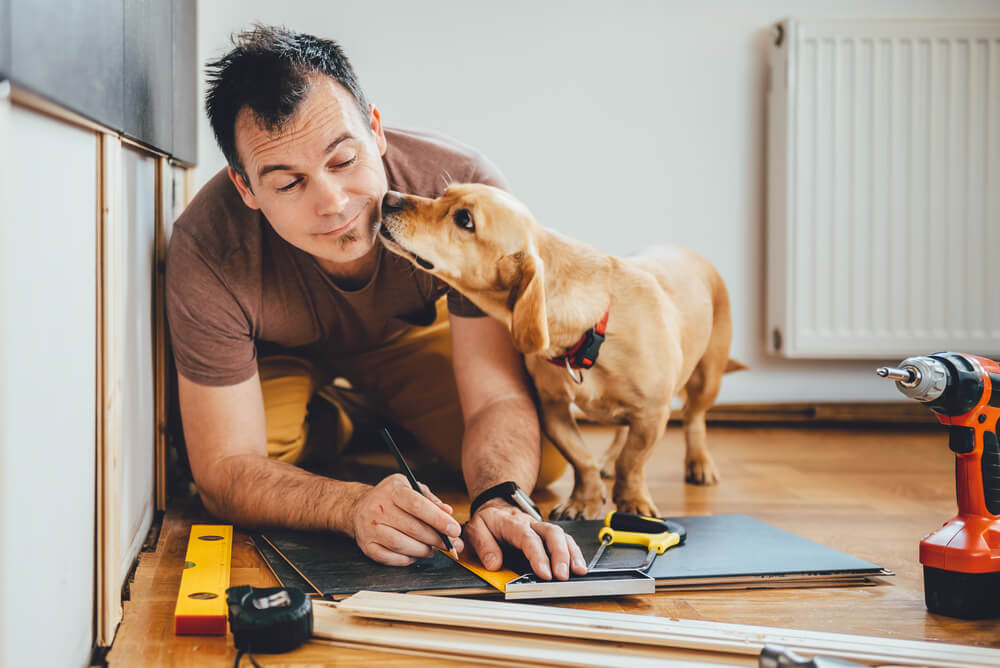Does Home Insurance Cover DIY? What You Need to Know About DIY Work and Home Insurance
If you’re planning some do-it-yourself (DIY) projects this spring, you should take into consideration how it might impact your insurance policy. Before getting started, inform your insurer about major renovations, adhere to your local building codes, and obtain any permits your local municipality requires. Standard homeowners insurance policies usually don’t cover damage from poor handiwork and unpermitted work.
While doing it yourself can save you money on contracting and other costs, there can be some problems, too. Hiring professionals for complex tasks, maintaining thorough documentation, and updating your policy post-renovation can help protect your home. Always consult your provider before starting significant DIY projects to avoid unintended coverage gaps or liabilities.
In this guide, you’ll learn more about the implications of DIY projects and your standard home coverage policy so you can answer the question, “Does home insurance cover DIY projects?”
Understanding Homeowners Insurance Coverage Basics
So, what exactly is homeowners insurance? This product is like a safety net for your house and the things you own. It helps pay for repairs or to replace things when things like a storm, theft, or fire happen. This covers your main house, any smaller buildings like sheds, and belongings inside the house. It even pays for any harm you might accidentally cause to someone else or their property.
It also helps cover the cost of a rental if your house gets so damaged you can’t live in it for a while. There are two main types of policies: one that covers almost everything except what it says it won’t and another that only covers things it specifically mentions.
When you have homeowners insurance, you need to pay a part of the repair costs yourself before the company pays the rest; this is called a deductible. The total amount the company will pay for a problem is called the coverage limit. The cost of your policy, called a premium, depends on how much your home is worth, where it is, the type of coverage you choose, and how likely it is for something bad to happen, like being in a place where floods or wildfires might happen.
It’s important to know what your insurance doesn’t cover, like floods or earthquakes, because you might need to buy extra coverage for those. Keeping your information updated and knowing how to file a claim when something goes wrong helps make sure you’re protected.

DIY Renovations and Their Impact on Your Policy
When you decide to make some changes to your house by yourself, like painting your room a new color or building a deck, it’s like giving your house a mini makeover. These do-it-yourself (DIY) projects can be fun and save you money, but they can also change things with your home insurance.
First off, if you make big changes, like adding a room or knocking down walls, your house might be worth more. This is great, but it also means you might need more insurance to cover the new value of your home. If something bad happens, like a fire or a storm, you want to make sure your policy will help pay to fix everything.
But there’s a catch. If you do the work yourself and it’s not done right, your policy might not cover the damage. For example, if you try to fix your plumbing and it leads to a flood, the insurer might decline to pay for the damages. They like it when professionals do the big jobs because they know how to do them correctly.
So, before you start a big project, it’s a good idea to determine what your home insurance covers. A professional can tell you how your project might affect your policy. And remember, for big or complicated projects, hiring a professional might be the best option. That way, you know the job is done right, and your insurer stays happy.
Risks Involved in Self-Managing Home Renovations
Taking on home renovation projects all by yourself can be thrilling. It’s exciting to pick out colors, tear down old wallpaper, or build something that makes your space better. But, just like in any adventure, there are risks involved.
First up, there’s the unexpected. Maybe you start knocking down a wall, thinking you’re creating your dream open concept living room, only to find out important wires or pipes are hidden in that wall.
Then, there’s the possibility the job might be beyond your skill level. Watching a couple of online tutorials can make you feel like a pro, but some tasks are trickier than they look.
Protections You Need Before You Hammer Away
Before you start, know exactly what you want to do and how much money you can spend. It’s easy to spend more than you want if you’re not careful.
Safety gear is important, too. Always wear goggles and gloves to protect you from splinters, dust, or anything else that could hurt you. Using the right tools for the job makes everything safer and easier, just like having the right pencil or calculator for homework.
Lastly, if the job looks too tough, it’s okay to ask for help from someone who knows what they’re doing, like a professional builder. Sometimes, getting help can make everything go smoother and turn out better in the end.
So, remember to get permission with permits, check with your insurer, make a good plan and budget, always use safety gear, and ask for help when you need it. This way, you’ll be all set to start DIY projects, and your homeowners insurance will stay in good standing!
Real-Life Scenarios Where DIY Can Affect Coverage
Here are some typical scenarios (including seasonal home improvements) where home insurance and DIY projects can conflict.
- Installing Your Own Roof: Imagine you decide to replace your old roof with a new one all by yourself. You watch some videos, buy the materials, and get to work. But if you don’t do it just right you may have a leak after a storm. Your insurer might not cover the damage. They could say the leak happened because the roof wasn’t installed professionally.
- DIY Plumbing: Does home insurance cover DIY plumbing? Let’s say you try to fix a leaky pipe under your kitchen sink without a plumber. It seems fine at first, but then the pipe bursts and floods your kitchen. Your insurer might check how the repair was done, and if they find out the flood was because of the DIY fix, they might not cover the repair costs.
- Electrical Work: You decide to add some new light fixtures or outlets and do the wiring yourself. Electrical work is tricky and dangerous. If a fire starts because of your electrical work, your insurer could say they won’t cover the damage if they learn you did the wiring without a professional electrician’s help.
FAQs on DIY Renovations and Home Insurance
If you’ve got questions about home renovation insurance, you’re not alone. The following are answers to some of the most common questions.
Is DIY Damage Covered by My Existing Homeowners Policy?
The best way to know for sure is to read your policy carefully and talk to your agent. It’s always a good idea to inform your insurer before starting significant renovations or DIY projects.
Will My Premiums Go Up If I Do Renovations Myself?
Doing renovations yourself can affect your homeowners insurance premiums, depending on the type of work and how it changes your home’s value or risk. Upgrades that increase value or improve safety could lead to higher or lower premiums, respectively, but poor or unpermitted work might raise premiums due to increased risk.
How Can I Ensure My Self-Performed Repairs Are Insured?
To ensure your self-performed repairs are insured, communicate with your insurance company before starting any major DIY projects to understand the impact on your coverage. Some insurers may offer home remodel coverage products that can help, too!
What Steps Should I Take if a DIY Reno Goes Wrong?
If a DIY renovation goes wrong, first stop any work to prevent further damage. Then, contact a professional to assess and repair the issue, and notify your company to understand if the damage is covered and how to proceed with a claim, keeping detailed records and photos of the damage and repairs.
What Common DIY Renovation Mistakes Can Void Your Insurance Policy?
Common DIY renovation mistakes that can void your policy include failing to obtain necessary permits, not adhering to local building codes, and performing work that significantly alters the structure or safety of your home without informing your insurer. These oversights can lead to denied claims or a lapse in coverage if damage occurs related to the unauthorized renovations.
Covering Your DIY Projects with Affordable Home Insurance
Ready to get started on your next DIY project? At Acceptance Insurance, our experienced agents can help ensure you have the best coverage for your needs. Call us today at (877) 405-7102, visit your local Acceptance office, or request a quote online today!



